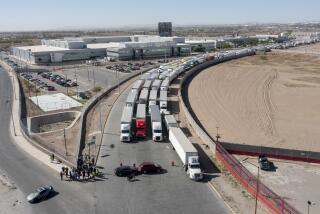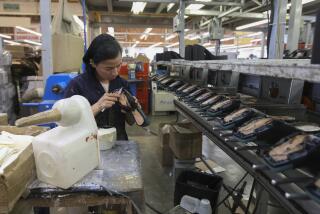Rift May Grow With China Trade Surplus
- Share via
SHANGHAI — China’s booming trade surplus in 2005 more than tripled to $101.9 billion, a record amount that is likely to stoke protectionist sentiment in the United States and Europe and renew pressure on Beijing to further revalue its currency.
A breakdown of Chinese exports and imports by industry and country won’t be available until later, but the U.S. is widely expected to show a record $200-billion trade deficit with China for 2005. Americans have been increasingly buying Chinese-made electronics, computers, clothes and toys, while the rate of U.S. shipments to China has eased.
The latest numbers could heighten tensions in U.S.-Sino economic relations, already strained last year by a prolonged standoff over Chinese textile exports. Although the row ended with Beijing agreeing to limit certain textile shipments to the U.S., China’s overall trade surplus is expected to widen in 2006.
“That’s going to mean more trade friction,” said Nicholas Lardy, a China expert and senior fellow at the Institute for International Economics in Washington. In fact, he said, tensions could only heighten because the trade surplus could become an issue in this year’s congressional elections.
A leading U.S. senator this week warned Chinese officials to take steps to reduce their nation’s trade surplus.
“U.S. politics on China will become unmanageable if China’s trade deficit with the U.S. continues to grow,” Max Baucus (D-Mont.), the top-ranking Democrat on the powerful Senate Finance Committee, said at a meeting with business executives in Beijing.
Similar tensions are brewing in Europe, where countries such as Britain and France are also contending with bulging trade deficits. The European Union last year squared off with China over textiles as well, and the two sides are feuding over EU threats to slap anti-dumping tariffs on Chinese-made footwear.
Increased tensions could hurt California’s trade-dependent economy, which is the leading gateway for trade with China and a top supplier of cotton to that nation’s textile and apparel mills. Surging trade with China contributed to another record year of container shipping volume in 2005 at the ports of Los Angeles and Long Beach, the nation’s busiest harbor complex. Officials estimate that the ports last year had a gain of at least 7% in large containers.
China’s trade surplus in 2005 was hardly a surprise to Chinese officials. The current uneven trade situation does pose a risk of destabilizing the global economy, said Mei Xinyu, a research fellow at the Ministry of Commerce in Beijing. But he said the U.S., whose consumers have been spending heavily and saving little, can’t ask China to reduce the surplus on its own.
Many Chinese workers, Mei said, have struggled with factory closures and shifts brought on by rapid development.
“Why can’t Western workers adapt themselves to this changing global economy?” he said.
Beijing officials, including the research head at China’s central bank, also have indicated recently that trading partners shouldn’t count on the Chinese currency to rise sharply anytime soon. Although China’s yuan has appreciated by 2.5% against the U.S. dollar since July -- when Beijing pegged the yuan’s value to a basket of currencies instead of the U.S. dollar -- U.S. and EU politicians and businesspeople say the yuan remains heavily undervalued, thus giving Chinese exporters an unfair advantage in selling their goods overseas.
Some Chinese companies, though, say the 2.5% rise in the yuan’s value already has cost them business, which may be supported by the statistics released Wednesday by the Ministry of Foreign Trade and Economic Cooperation. The data show that China’s exports in the last two months of 2005 grew by about 18%, down from 30% earlier last year. What’s more, the pace of Chinese imports ticked up a bit in December.
This more-recent trend may help Chinese officials deflect some of the increasing pressure from the West.
Still, China’s annual trade figures suggest that net exports may have accounted for as much as one-third of its booming economic growth last year, a huge increase from 2004, Lardy of the Institute for International Economics said. If that trend continues, it’ll probably mean trade deficits -- and political backlash -- will intensify in the West.
Although Chinese exports maintained their rapid pace of expansion, growth of imports in 2005 weakened markedly from the previous year, in large part because of a slowdown in orders for machinery and equipment as Beijing sought to cool surging growth in certain sectors such as steel. China’s oil imports also slowed last year.
Managers at Aokang Group Co. are bracing for political backlash from the trade surplus.
The private company is one of the largest of about 4,000 shoe producers in Wenzhou, a city south of Shanghai that is China’s footwear manufacturing capital.
Although shoe manufacturing has virtually disappeared in the U.S., the industry remains formidable in nations such as Italy, Spain and France. Chinese shoe exports to EU nations have jumped in the last year after the removal of quotas as part of China’s entry into the World Trade Organization in 2001.
Aokang’s own exports and imports mirror China’s overall trade pattern in the last two years. In 2004, the company spent millions of dollars to build a new export-production factory in Wenzhou, establishing 14 assembly lines outfitted entirely with equipment from Italy and hiring about 1,400 workers to do such jobs as stitching, gluing and polishing shoes.
Last year, the 18-year-old company bought few machines from overseas, but its sales overseas soared. With the EU’s removal of shoe quotas and strong demand from the U.S. and Asia, Aokang’s exports surpassed a million pairs last year, double the volume of 2004. Among its export customers are Payless ShoeSource Inc. in the U.S. and Geox, a high-end Italian casual shoe company, which is marketing its brand in China through Aokang.
Aokang also makes about 8 million pairs for the Chinese market.
Lian Quanwen, the company’s import-export manager, said Aokang had worked hard on building its own brand and a global reputation. But if the EU imposes tariffs on Chinese shoes, he said, they’ll apply equally to all manufacturers in China, whether they sell goods for $1 a pair, as many do, or the $15 or more that Aokang fetches from overseas buyers.
“Because of the uncertainty of anti-dumping measures, many of our EU clients are holding off on orders now,” said Lian, a former English teacher in Xian who joined Aokang in 1999.
“If one day anti-dumping turns out to be reality, it’ll have a great effect on us and our partner companies,” he said. “We may have to set up a new company in Hong Kong so we can export from there.”
Times staff writer Evelyn Iritani in Los Angeles contributed to this report.
More to Read
Sign up for Essential California
The most important California stories and recommendations in your inbox every morning.
You may occasionally receive promotional content from the Los Angeles Times.











